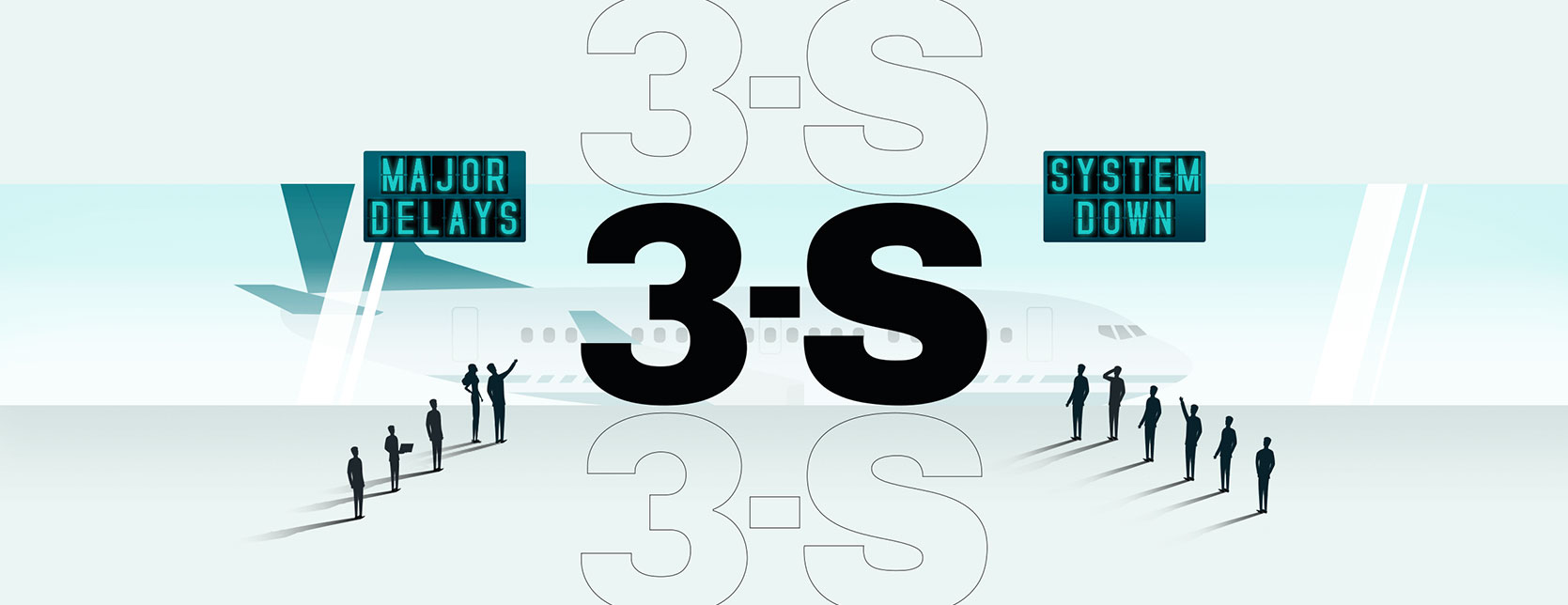Tech turbulence: The impact of the aviation industry’s delay in modernizing IT infrastructure

It’s late December 2022. Holiday cheer abounds, and New Year’s resolutions are in the making. The only places bustling more than malls are airports.
When we travel around the holidays, most of us expect a certain amount of stress, and there’s always a risk of weather-related delays. With the impending “bomb cyclone,” Winter Storm Elliot, this period of 2022 was fraught with uncertainty for people on the move.
Weathering two storms
Starting on December 23, the powerful cyclone grounded more than 17,000 flights nationwide. Many airlines, including Delta, American and United, faced bottlenecks, an all-too-familiar story. Despite heavy investment in systems and careful orchestration by leading IT experts, technology failed to perform under extreme pressure.
Southwest Airlines, for one, found itself in a dire situation. Even after the storm cleared, its systems were still struggling. Between December 26 and 31, the popular airline had to cancel up to 70% of its flights every day — largely due to its inability to assign crews to the flights that were still scheduled. Millions of passengers were stuck.
Southwest expressed sincere apologies: “Our employees and crews scheduled to work this holiday season are showing up in every single way. We are beyond grateful for that. Our shared goal is to take care of every single customer with the hospitality and heart for which we’re known.”
Despite these sentiments and round-the-clock efforts to correct the problem, operational disruptions continued beyond that week, making many travelers hesitant to book future trips. The debacle cost Southwest nearly a billion dollars in net outlay and lost revenue. Compounded by viral negative stories circulating on social media, the financial repercussions dealt a considerable blow.
Runway to ruin: Origins of an industry predicament
The cause of the storm after this storm wasn’t the snow and ice blanketing the runways. It was invisible — embedded in the legacy infrastructure underpinning many airlines’ operations.
This was not merely an instance of management neglecting to anticipate weather impacts but a fundamental flaw in backend IT setup. Many large corporations continue to use the same technology that drove successful outcomes for years without realizing the magnitude of risk involved, sometimes thinking any system upgrade or migration would be too much. Relying on outmoded systems for critical processes is costly yet common.
Four root causes of the aviation industry’s struggles stand out.
1. Archaic technological architecture
At the heart of operational dysfunction is often a struggling gate check-in and check-out system, which may rely on an outdated job scheduler. Ill-equipped to handle the complexities and rapid changes required in modern air travel logistics, old systems don’t perform well under stress. Any disruption in the schedule could lead to widespread systemic failure.
Just a couple weeks after Elliot passed, the Federal Aviation Administration experienced an outage of its 30-year-old NOTAM system, which is critical for the safety of all US flights. Thus, the effects of obsolete technology aren’t limited to private companies but also regulatory bodies.
2. Increasing enterprise complexity
The complexity of today’s enterprise environment further complicated the 2022 event and presents an ongoing dilemma. Digital transformation has, for many organizations, meant increasing the number of tools used for everyday work. On average, a large enterprise uses 473 SaaS applications.
If integrations aren’t seamless, this expansiveness breeds information silos and a disjointed system that isn’t equipped for large and intricate workloads. Delayed responses in critical times are, therefore, not surprising.
3. No true workflow orchestration system
Many airlines also lack effective workflow orchestration, depending on custom-scripted automations that weren’t designed for rapid adaptability or scalability. The absence of a robust, integrated workflow system means they’re not prepared to recalibrate in the worst-case scenario.
4. Missed signs of impending breakdown
Technology crises don’t generally occur without warning. For instance, a smaller system outage occurred two years prior in Southwest’s Atlanta hub, highlighting vulnerabilities that were bound to worsen if not addressed. It’s understandable that this would have been overlooked, as it’s not necessarily obvious that a particular outage across such an intricate system is the one signaling a major problem in the near future. However, more sophisticated systems would be able to predict system issues before they grow to the scale of the 2022 debacle.
The value of seamless data flows in preventing operational chaos
In this tale are priceless lessons for complex enterprises in any industry. It’s a stark reminder of the role of modern, resilient technology in a crisis response strategy.
The most prominent message? Seamless data flows aren’t just part of a secure IT foundation. Implemented correctly, they can be a business advantage and ensure your architecture stands up to pressure when your competitors’ may not. Reliable, powerful technology is instrumental in preventing delayed responses, misinformation and downtime.
Good data is anticipatory — it allows you to predict challenges. Organizations with agile, data-driven processes can see what’s coming and pivot effectively, a significant competitive advantage when external factors like weather impact an entire industry.
Should an unforeseen event occur, continuous data flows are the best form of insurance, as they protect your business in real time. When data moves unhindered across departments and systems, it minimizes downtime and the costs associated with it. In turn, this reduces the indirect costs of lost customer trust and potential market share.
4 top data flow strategies to protect your enterprise
- Adopt cloud technologies. Cloud platforms offer numerous advantages for data quality and management. They support business continuity by speeding up data transfer and centralizing your key data for global visibility.
- Integrate advanced analytics. On-point insights drive smarter decisions. Not only will they equip you to preempt potential issues, but they’ll enable you to respond confidently in tough situations.
- Invest in real-time data processing. All processes begin and end with data. Every person in your organization must have the most current information at their fingertips in a stormy moment. Uninterrupted data flows are also helpful after the fact to mitigate long-term impacts when things do go awry.
- Perform regular audits. Auditing data flows and IT systems regularly can reveal vulnerabilities before they cause problems. There’s no post-disaster equivalent to prevention.
An alternate route
How could things have gone differently for airlines with a more modern IT environment in the midst of this major storm?
Fewer, newer and more tightly integrated systems would have removed the manual burden of disaster recovery and reduced the scale of the consequences. Specifically, end-to-end automation could have dramatically improved crew scheduling and reassignment to reroute resources where they were most needed. Real-time data inputs from weather services and airport traffic updates could have preemptively adjusted flight schedules.
The customer experience, while not entirely protected from disruption, could have been far less catastrophic, with automations triggering customer alerts and eliminating the need to stand in long lines for answers.
German utility provider on RunMyJobs by Redwood: “It just runs”
There’s proof that uniting diverse applications and data sources results in greater access and control — in good times and bad. Using the advanced job scheduling capabilities of RunMyJobs, Stadtwerke München (SWM) brought together mass activity transactions and data from ERPs and set up business process automations, some of which reduced manual effort by 77%. Their customers are happier, and recovery plans are in place. Read the full story.
How to navigate an application-heavy landscape
Still not convinced it’s time for IT infrastructure modernization initiatives at your organization? Let’s look to the future.
Sophisticated technologies are arriving on the business scene at an exponential rate. On top of the immense number of apps you already use, you’ll likely be looking to fully utilize the power of machine learning and AI to transform your business operations and keep up.
However well-intentioned, these moves increase the chance of system failure if they’re not done well. Stacking more complexity on top of an already overwhelmed mainframe or legacy infrastructure is a sure way to kill any amount of operational efficiency you’ve maintained until now.
Interconnection and interdependence are mandates in today’s (and tomorrow’s) IT operations, and every enterprise must evolve to support them. You need your business processes to run at scale — millions of times per year, across your architecture, uninterrupted. To achieve this and stay competitive, you simply must automate.
A storm-ready modernization strategy
Automating single tasks in silos is not the answer. Instead, aim to implement an automation fabric — a single, integrated framework that unites all of your activities, applications and environments and orchestrates mission-critical business processes. This approach is essential for modernizing your infrastructure and solving for the complexity of the application explosion.
Here’s how to stay ready for the equivalent of a severe winter storm during the holiday travel period in your industry.
- Don’t overlook warning signs. Your systems speak! The longer you ignore a “check engine” light, the bigger and more costly the issue could become. While your backend may not be revenue-generating, it is revenue-protective.
- Choose forward-thinking software providers. Invest in relationships with software providers who prioritize innovation and adaptability while considering your business needs. They’ll offer solutions that are adaptable to changes in technology to ensure your ecosystem doesn’t become obsolete.
- Safeguard your organization with workload automation. Instead of fighting to make monolithic, inflexible systems do what you want, streamline and build efficient end-to-end processes you can rely on.
Clear your organization for takeoff
Imagine a plane from the 1960s taking off next to one built in 2024. While it could theoretically get off the ground, problems verifying the safety of parts, finding pilots who can fly it and speaking to air traffic control and more would make it impossible to try.
Today’s plane is your competition. They will modernize whether you do or not. Therefore, trouble is inevitable if you fall behind, whether it manifests as a few days, hours or minutes of chaos.
Modern enterprise scheduling can pull you forward from an archaic space to help you level with the best in your market today, tomorrow and beyond. The key is to find a solution that can do the job. Many job schedulers haven’t shifted their architecture or offerings in 15 to 25 years.
Redwood Software, on the other hand, has been live with SaaS for over 10 years. The full stack automation platform that’s purpose-built to orchestrate your mission-critical business processes, RunMyJobs gives you a single pane of glass to turn your business operations into a business advantage.
Don’t wait to get off the ground. Demo RunMyJobs today.
About The Author

Michael Wooldridge
Michael Wooldridge is an Enterprise Account Executive in the Regulated Industries practice at Redwood Software. A seasoned executive with extensive experience in technology services and software, he excels in consulting and driving growth for Redwood’s automation software portfolio within Regulated Industries.
Throughout his two-decade career, Michael has worked extensively with Fortune 500 companies and the federal government to transform their organizations to the cloud. He brings a wealth of knowledge and experience in organizational change management and technology transformation across various industries.
